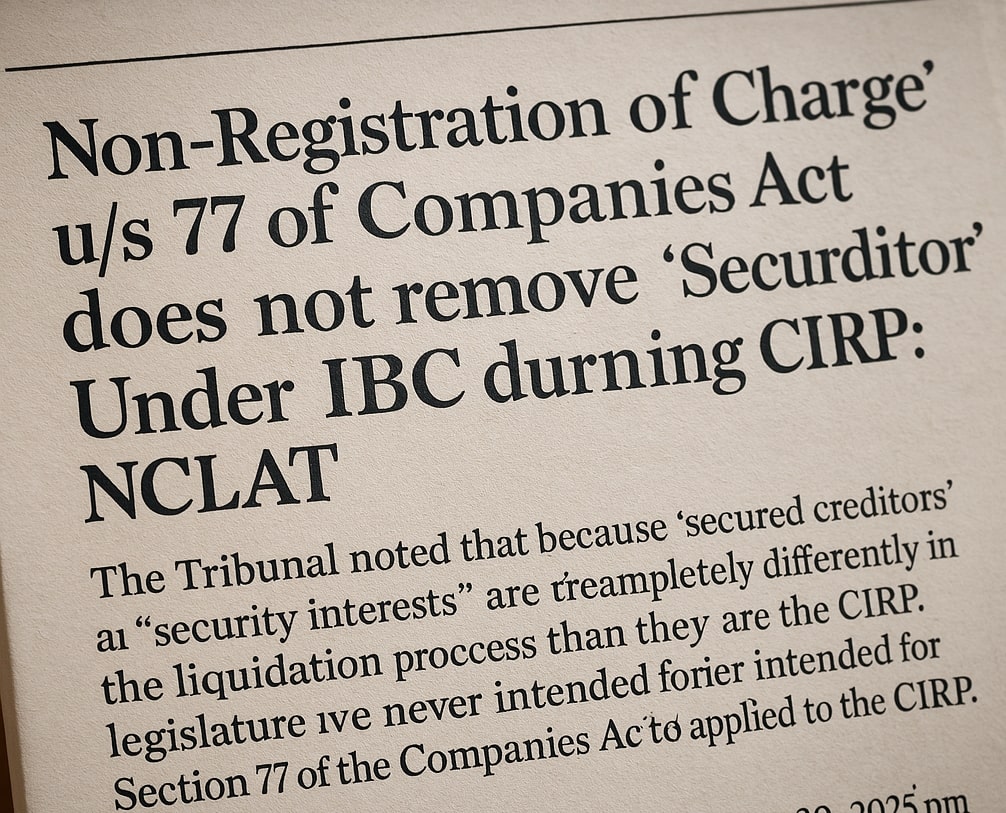View News
Non-Registration-of-Charge-under-Section-of-the-Companies-Act-does-not-Remove-Secured-Creditor-Status-under-ibc-NCLAT

Non-Registration of Charge under Section 77 of the Companies Act does not Remove Secured Creditor Status under IBC: NCLAT
Legal Provision
The National Company Law Appellate Tribunal (NCLAT), New Delhi, has ruled that a creditor may be considered a "Secured Creditor" under Section 3(30) of the Insolvency and Bankruptcy Code, 2016 (IBC) by the Resolution Professional (RP), even if they have not registered a "charge" in accordance with Section 77 of the Companies Act, 2013. The Tribunal clarified that Section 77 of the Companies Act is relevant in the liquidation process but does not affect the secured status of a creditor during the Corporate Insolvency Resolution Process (CIRP).
Facts of the Case
Home Kraft Avenues, the appellant, had granted a loan of Rs. 11 crores to the Corporate Debtor through a loan agreement dated 29.10.2015. The agreement provided two options for interest repayment:
-
Interest at the rate of 18% per annum, or
-
Transfer of four apartments in favor of the appellant towards full and final settlement of interest.
The agreement also stated that if the Corporate Debtor failed to repay the principal amount, the four apartments would be transferred to the appellant. Since the Corporate Debtor failed to repay the principal, the appellant filed claims during CIRP for:
-
Rs. 11 crores as a "secured financial creditor"
-
Ownership rights over the four apartments
The RP accepted the appellant’s claim regarding the four apartments but denied the secured creditor status for the principal loan amount, citing the absence of charge registration under Section 77 of the Companies Act, 2013. Dissatisfied with this decision, the appellant challenged it before the NCLAT.
Issue
The primary issue before the NCLAT was whether the non-registration of a charge under Section 77 of the Companies Act, 2013, prevents a financial creditor from being treated as a "Secured Creditor" under IBC during CIRP.
Judgment and Observations
The NCLAT ruled in favor of the appellant, holding that:
-
The legislature never intended for Section 77 of the Companies Act to apply to CIRP since the treatment of "secured creditors" and "security interests" differs between CIRP and liquidation.
-
During CIRP, as per Sections 18(1)(f) and 25(2)(a) of the IBC, the RP is required to take custody of "all assets" of the Corporate Debtor, including encumbered assets, meaning that secured creditors cannot enforce security interests at this stage.
-
In the liquidation process, secured creditors have an indefeasible right to realize security under Section 52 of the IBC, provided a charge is registered under Section 77 of the Companies Act.
-
Regulation 21 of the IBBI (Liquidation Process) Regulations, 2016 prescribes the evidence required to establish "security interest." However, the IBBI (CIRP) Regulations, 2016 contain no such requirement.
-
The requirement of charge registration under Section 77 arises only during liquidation and does not affect the recognition of a secured creditor during CIRP.
Conclusion
The NCLAT allowed the appeal, holding that the appellant was a "secured financial creditor" despite the non-registration of the charge under Section 77 of the Companies Act, 2013. The Tribunal reaffirmed that during CIRP, a debt backed by a security interest remains secured regardless of charge registration, and such registration is only necessary if a secured creditor wishes to enforce rights outside the waterfall mechanism in liquidation under Section 53 of the IBC. This ruling provides clarity on the status of secured creditors in insolvency proceedings and affirms that security interest, rather than formal charge registration, determines secured creditor status during CIRP.
"Unlock the Potential of Legal Expertise with LegalMantra.net - Your Trusted Legal Consultancy Partner”
DISCLAIMER: THE CONTENTS OF THIS DOCUMENT ARE PROVIDED BASED ON CURRENT PROVISIONS AND INFORMATION AVAILABLE. WHILE EVERY EFFORT HAS BEEN MADE TO ENSURE ACCURACY AND RELIABILITY, NO RESPONSIBILITY IS ASSUMED FOR ANY ERRORS OR OMISSIONS. USERS ARE ENCOURAGED TO REFER TO APPLICABLE LAWS AND REGULATIONS. THIS INFORMATION IS NOT TO BE CONSTRUED AS LEGAL ADVICE, AND NO LIABILITY IS ACCEPTED FOR ANY CONSEQUENCES ARISING FROM ITS USE.

